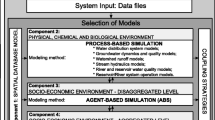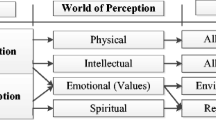Abstract
Hybrid socio-hydrological modeling has become indispensable for managing water resources in an increasingly unstable ecology caused by human activity. Most work on the subject has been focused on either qualitative socio-political recommendations with an unbounded list of vague factors or complex sociological and hydrological models with many assumptions and specialized usability. In this paper, we propose a simple agent-based socio-hydrological decision modeling framework for coupling dynamics associated with social behavior and groundwater contamination. The study shows that using social health risk, instead of contaminant concentration, as an optimization variable improves water management decisions aimed at maximizing social wellbeing. The social models and computational framework are designed with enough flexibility and simplicity to encourage extensions to more general socio-hydrological dynamics without compromising either computability or complexity for better data-/model-driven environmental management.










Similar content being viewed by others
References
Akhbari M, Grigg NS (2013) A framework for an agent-based model to manage water resources conflicts. Water Resour Manage 27(11):4039–4052. doi:10.1007/s11269-013-0394-0
Akhbari M, Grigg NS (2015) Managing water resources conflicts: modelling behavior in a decision tool. Water Resour Manage 29(14):5201–5216. doi:10.1007/s11269-015-1113-9
Atchley AL, Maxwell RM, Navarre-Sitchler AK (2013) Human health risk assessment of CO2 leakage into overlying aquifers using a stochastic, geochemical reactive transport approach. Environ Sci Technol 47(11):5954–5962. doi:10.1021/es400316c
Bednar J, Bramson A, Jones-rooy A (2006) Conformity, consistency, and cultural heterogeneity Inproceedings of annual meeting of the american political science association, Marriott, Loews Philadelphia, and the Pennsylvania convention, p 150817
Berger T, Birner R, Mccarthy N, Díaz J, Wittmer H (2007) Capturing the complexity of water uses and water users within a multi-agent framework. Water Resour Manage 21(1):129–148. doi:10.1007/s11269-006-9045-z
Biswas AK (2008) Integrated water resources management: is it working? Int J Water Resour Dev 24(1):5–22. doi:10.1080/07900620701871718
Boone RB, Galvin KA (2014) Simulation as an approach to social-ecological integration, with an emphasis on agent-based modeling. In: Manfredo MJ, Vaske JJ, Rechkemmer A, Duke EA (eds) Understanding society and natural resources. doi:10.1007/978-94-017-8959-2_9. Springer, Netherlands, pp 179–202
Borowski I, Hare M (2007) Exploring the gap between water managers and researchers: difficulties of model-based tools to support practical water management. Water Resour Manage 21(7):1049–1074. doi:10.1007/s11269-006-9098-z
Cialdini RB, Goldstein ANJ (2004) Social influence: compliance and conformity. Annu Rev Psychol 55(1):591–621. doi:10.1146/annurev.psych.55.090902.142015
Cook BI, Anchukaitis KJ, Touchan R, Meko DM, Cook ER (2016) Spatiotemporal drought variability in the Mediterranean over the last 900 years. J Geophys Res Atmos 121(5):2015JD023,929. doi:10.1002/2015JD023929
Culver TB, Shoemaker CA (1992) Dynamic optimal control for groundwater remediation with flexible management periods. Water Resour Res 28(3):629–641
Dayan A, Paine A (2001) Mechanisms of chromium toxicity, carcinogenicity and allergenicity: review of the literature from 1985 to 2000. Hum Exp Toxicol 20(9):439–451
Dooley JJ (2013) Human choice and ccs deployment: what have we learned from the social sciences about ccs?. Int J Greenhouse Gas Control 17:v–vi. doi:10.1016/j.ijggc.2013.05.028. http://www.osti.gov/scitech/biblio/1091436-human-choice-ccs-deployment-what-have-we-learned-from-social-sciences-about-ccs
Epstein JM (2006) Generative social science: studies in agent-based computational modeling. Princeton University Press
Flynn J, Slovic P, Mertz CK (1994) Gender, race, and perception of environmental health risks. Risk Anal 14(6):1101–1108. doi:10.1111/j.1539-6924.1994.tb00082.x
Hanna-Attisha M, LaChance J, Sadler RC, Champney Schnepp A (2015) Elevated blood lead levels in children associated with the flint drinking water crisis: a spatial analysis of risk and public health response. Am J Public Health 106(2):283–290. doi:10.2105/AJPH.2015.303003
Kandasamy J, Sounthararajah D, Sivabalan P, Chanan A, Vigneswaran S, Sivapalan M (2014) Socio-hydrologic drivers of the pendulum swing between agricultural development and environmental health: a case study from murrumbidgee river basin, Australia. Hydrol Earth Syst Sci 18(3):1027–1041. doi:10.5194/hess-18-1027-2014
Lin Y, O’Malley D, Vesselinov VV (2016) A computationally efficient parallel Levenberg-Marquardt algorithm for highly parameterized inverse model analyses. Water Resour Res 1–70. doi:10.1002/2016WR019028
Mann ME, Gleick PH (2015) Climate change and california drought in the 21st century. PNAS 112(13):3858–3859. doi:10.1073/pnas.1503667112. http://www.pnas.org/content/112/13/3858
Nikolic VV, Simonovic SP (2015) Multi-method modeling framework for support of integrated water resources management. Environ Process 2(3):461–483. doi:10.1007/s40710-015-0082-6
Rayner S (2012) Uncomfortable knowledge: the social construction of ignorance in science and environmental policy discourses. Econ Soc 41(1):107–125. doi:10.1080/03085147.2011.637335
Schlüter M, Mcallister RRJ, Arlinghaus R, Bunnefeld N, Eisenack K, Hölker F, Milner-Gulland E, Müller B, Nicholson E, Quaas M, Stöven M (2012) New horizons for managing the environment: a review of coupled social-ecological systems modeling. Nat Resour Model 25(1):219–272. doi:10.1111/j.1939-7445.2011.00108.x
Sivapalan M, Savenije HHG, Blöschl G (2012) Socio-hydrology: a new science of people and water. Hydrol Process 26(8):1270–1276. doi:10.1002/hyp.8426
Slovic P, Weber EU (2013) Perception of risk posed by extreme events SSRN scholarly paper ID 2293086. Social Science Research Network, Rochester, NY. http://papers.ssrn.com/abstract=2293086
Tietenberg TH, Lewis L (2016) Environmental and natural resource economics. Routledge
US EPA O Table of regulated drinking water contaminants. https://www.epa.gov/ground-water-and-drinking-water/table-regulated-drinking-water-contaminants#one
Vesselinov V, Neuman S, Illman W (2001) Three-dimensional numerical inversion of pneumatic cross-hole tests in unsaturated fractured tuff 1. Methodology and borehole effects. Water Resour Res 37(12). doi:10.1029/2000WR000133
Walker WE, Loucks DP, Carr G (2015) Social responses to water management decisions. Environ Process 2(3):485–509. doi:10.1007/s40710-015-0083-5
Yuan XC, Wei YM, Pan SY, Jin JL (2014) Urban household water demand in Beijing by 2020: an agent-based model. Water Resour Manage 28(10):2967–2980. doi:10.1007/s11269-014-0649-4
Acknowledgements
JB and VV acknowledge the programmatic support from the LANL Environmental Management Directorate. DO acknowledges the support of a Los Alamos National Laboratory Director’s Postdoctoral Fellowship during the preparation of this manuscript. VV also acknowledges supported by the DiaMonD project (An Integrated Multifaceted Approach to Mathematics at the Interfaces of Data, Models, and Decisions, U.S. Department of Energy Office of Science, Grant #11145687).
Author information
Authors and Affiliations
Corresponding author
Electronic supplementary material
Below is the link to the electronic supplementary material.
Appendices
Appendix A: Social Dynamics
In this study, the results shown in Section 5 highlight the average dynamics of the entire society, expressed in terms of average social health risk and total water usage. However, it must be noted that even when the contaminant concentration or health risk reach quasi-constant value, individuals are always changing their usage habits and beliefs. This means that even though the regulators manage the average behavior and beliefs of a society, the beliefs and behavior of every single individual is uncontrollable and unpredictable. Figure 11 shows the social dynamics of a sample of the population (100 individuals) changing attributes (usage and beliefs) throughout 100 years of simulation. On the left, the population is sorted according to specialty. The first 20 individuals (shown in the bottom of the abscissa axis) are initially experts who turn into normal citizens when not employed by the regulators. The right plot shows the population sorted by attributes.
Dynamics of usage and belief over time for a representative sample of the population (100 individuals); the left subgraph shows the changes in the social attributes over time for each individual in the sample (the first 20 people, shown at the figure bottom, are initially experts who turn into normal citizens when not employed by the regulators); the right subgraph shows the population sorted by attributes
Appendix B: Analogy Between Water Resources Management and Proportional-Integral-Derivative (PID) Control
Social-ecological system management fits naturally in the framework of control theory. According to this analogy, shown in Fig. 12, the decision makers are the controllers, the plant is the social-environmental system and the sensors are managed by scientists and engineers. If a social-ecological system is unstable (i.e. threatens a deterioration of either the environment or social well-being) environmental management decisions aim at restoring the balance (i.e. reach a reference state) of the ecosystem (i.e. the social-environmental plant). In the context of control theory, this is done by minimizing the difference between a reference well-balanced state and a present unsustainable state. In this study, the control (management) variables of interest are health risk and contaminant concentration.
The proportional (K p), integral (K i) and derivative (K d) constants are tweaked to minimize the rise time to steady state and dampen the oscillations as much as possible. However, the values are not optimal. The choice is only meant to illustrate the advantage of using PID control in the context of environmental management.
About this article
Cite this article
Bakarji, J., O’Malley, D. & Vesselinov, V.V. Agent-Based Socio-Hydrological Hybrid Modeling for Water Resource Management. Water Resour Manage 31, 3881–3898 (2017). https://doi.org/10.1007/s11269-017-1713-7
Received:
Accepted:
Published:
Issue Date:
DOI: https://doi.org/10.1007/s11269-017-1713-7






